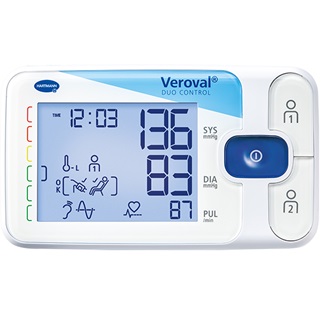Veroval® Duo Control Upper Arm Blood Pressure Monitor

Learn more about your heart health
To determine your blood pressure, two values have to be measured:
The measured values for blood pressure are displayed in mmHg.
To better evaluate the results, Veroval® blood pressure monitors offer a traffic light colour system that directly describes the results to enable easier categorisation of the measured value. The World Health Organisation (WHO) and the European Society of Cardiology (ESC) & European Society of Hypertension (ESH) have developed the following summary for classifying blood pressure values:

The decision about which type of blood pressure monitor to use is mostly a matter of personal preferences. Regarding the requirements for technical measurement accuracy, clinical tests and tests for legal conformity, there are no differences between wrist and upper arm devices, so basically you could use every Veroval® blood pressure monitor.
However, there are certain advantages to each of the device types which you can consider when making your decision:
If you already suffer from cardiovascular diseases such as cardiac arrhythmias, the upper arm blood pressure monitor Veroval® duo control should be your first choice for measuring your blood pressure daily. To ensure high precision even with cardiac arrhythmias, the Veroval® duo control measures blood pressure with DUO SENSOR technology
In addition to cardiac arrhythmias, we recommend upper arm devices for people with vascular diseases, diabetes mellitus and for users over the age of 60. Due to the constriction of the vessels, it is easier to obtain more accurate values with upper arm devices. For accurate blood pressure readings, the correct position of the cuff at heart level during the measurement is very important. This is particularly easy with an upper arm device, as it is already ensured when the cuff is applied to the arm. For users who are unable or find it difficult to apply an upper arm cuff, a wrist device is recommended. Reasons for this can be too-large upper arms, obesity, or limited mobility.
In case you are not affected with either one of the conditions mentioned above, and you are looking for an easy to handle device, a wrist blood pressure monitor offers fast measurement and convenient handling. For your best personal health, we recommend choosing the model you feel most comfortable with, because what matters most is that you measure your blood pressure frequently and regularly at home.
There are many behavioural risk factors for the development of hypertension, including:
In addition, there are several metabolic factors, including:
Secondary causes might be:
In some cases there is no known specific cause for hypertension. Genetic factors may play a role.
Cardiovascular risk is a person's risk of developing a cardiovascular disease (CVD).
The exact cause of CVD isn't clear, but there are lots of things that can increase the risk of getting it. These are called "risk factors". The more risk factors you have, the greater your chances of developing CVD.
The main risk factors for CVD are outlined below.
The more of these risk factors apply, the higher the cardiovascular risk.
Cardiovascular disease (CVD) is a general term for conditions affecting the heart or blood vessels. CVDs are usually associated with a build-up of fatty deposits inside the arteries (atherosclerosis) and an increased risk of blood clots. They can also be associated with damage to arteries in organs such as the brain, heart, kidneys and eyes.
There are many different types of CVD. Four of the main types are:
Your blood pressure values change naturally many times a day. Most fluctuations are normal and caused for example by the time of the day, physical activity, stress or weather. Our internal clock influences and controls the daily sequence of many processes in our body, including blood pressure.
Fluctuations are therefore natural, and blood pressure usually has a daily pattern with two natural peaks during the course of the day:
Morning: blood pressure reaches its highest level, usually in the first two hours after awakening.
Noon to early afternoon: values drop slightly.
Evening: blood pressure rises again and reaches a second high point.
Night: blood pressure drops to its lowest level, which is often about 10 to 15 % lower than the daytime value.
Veroval® blood pressure monitors follow the recommendations of the European Society of Hypertension (ESH) and differentiate between measurements taken in the morning and those taken in the evening. With this information, your doctor is more likely to identify the right treatment for you if you should need medical treatment for high blood pressure.
If you notice irregular or high fluctuations in your daily blood pressure, there is an increased risk of circulatory disease, which should be checked by your doctor.